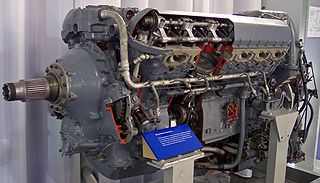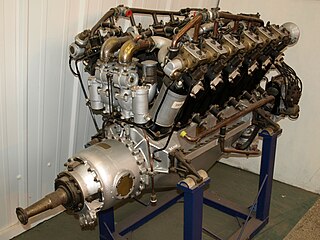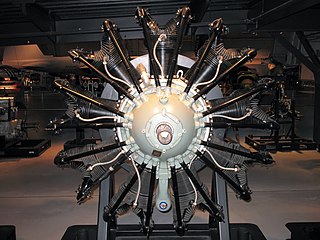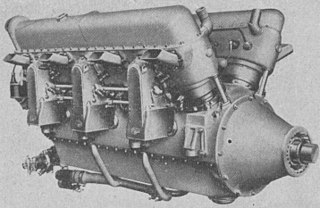
A turboprop is a turbine engine that drives an aircraft propeller.

Overdrive is the operation of an automobile cruising at sustained speed with reduced engine speed (rpm), leading to better fuel consumption, lower noise, and lower wear. The term is ambiguous. The most fundamental meaning is that of an overall gear ratio between engine and wheels, such that the car is over-geared, and cannot reach its potential top speed, i.e. the car could travel faster if it were in a lower gear, with the engine turning at higher RPM.
Torsional vibration is the angular vibration of an object - commonly a shaft - along its axis of rotation. Torsional vibration is often a concern in power transmission systems using rotating shafts or couplings, where it can cause failures if not controlled. A second effect of torsional vibrations applies to passenger cars. Torsional vibrations can lead to seat vibrations or noise at certain speeds. Both reduce the comfort.

The Rolls-Royce Griffon is a British 37-litre capacity, 60-degree V-12, liquid-cooled aero engine designed and built by Rolls-Royce Limited. In keeping with company convention, the Griffon was named after a bird of prey, in this case the griffon vulture.

The Rolls-Royce Eagle Mk XXII is a British 24-cylinder, sleeve valve, H-block aero engine of 46 litre displacement. It was designed and built in the early-1940s by Rolls-Royce Limited and first ran in 1944. It was liquid-cooled, of flat H configuration with two crankshafts and was capable of 3,200 horsepower at 18 psi boost.

The Rolls-Royce Falcon is an aero engine developed in 1915. It was a smaller version of the Rolls-Royce Eagle, a liquid-cooled V-12 of 867 cu in capacity. Fitted to many British World War I-era aircraft, production ceased in 1927. The Falcon was designed by R.W. Harvey-Bailey.

A reduction drive is a mechanical device to shift rotational speed. A planetary reduction drive is a small scale version using ball bearings in an epicyclic arrangement instead of toothed gears.

The Armstrong Siddeley Python was an early British turboprop engine designed and built by the Armstrong Siddeley company in the mid-1940s. Its main use was in the Westland Wyvern, a carrier-based heavy fighter. The prototypes had used the Rolls-Royce Eagle piston engine, but Pythons were used in production aircraft. In this application, the Python was rated at 4,110 equivalent shaft horsepower (eshp).

A harmonic damper is a device fitted to the free end of the crankshaft of an internal combustion engine to counter torsional and resonance vibrations from the crankshaft. This device must be an interference fit to the crankshaft in order to operate in an effective manner. An interference fit ensures the device moves in perfect step with the crankshaft. It is essential on engines with long crankshafts and V8 engines with cross plane cranks, or V6 and straight-three engines with uneven firing order. Harmonics and torsional vibrations can greatly reduce crankshaft life, or cause instantaneous failure if the crankshaft runs at or through an amplified resonance. Dampers are designed with a specific weight (mass) and diameter, which are dependent on the damping material/method used, to reduce mechanical Q factor, or damp, crankshaft resonances.

The General Electric T31 was the first turboprop engine designed and built in the United States.
The Fairey P.16 Prince was a British experimental 1,500 hp 16-cylinder H-type aircraft engine designed and built by Fairey in the late 1930s. The engine did not go into production.

The Fiat AS.6 was an unusual Italian 24-cylinder, liquid-cooled V configured aircraft racing engine designed and built in the late-1920s by Fiat especially for the Schneider Trophy air races, but development and running problems meant that it was never able to compete. Although the engine suffered from technical problems, it was later used to set a speed record for piston-powered seaplanes that still stands today.

The Pratt & Whitney R-1860 Hornet B was a relatively uncommon aircraft engine. It was a development of Pratt & Whitney's earlier R-1690 Hornet and was basically similar, but enlarged in capacity from 1,690 to 1,860 cubic inches (30.5 L). Cylinder bore was increased by 1/8" and the crankshaft stroke by 3/8". Both engines were air-cooled radial engines, with a single row of nine cylinders.

The Lorraine 12H Pétrel was a French V-12 supercharged, geared piston aeroengine initially rated at 370 kW (500 hp), but later developed to give 640 kW (860 hp). It powered a variety of mostly French aircraft in the mid-1930s, several on an experimental basis.
The Wright R-4090 Cyclone 22 was an American experimental radial piston engine designed and built in prototype form by Wright Aeronautical during the 1940s.

The Packard X-2775 was an American experimental liquid-cooled aircraft engine. The engine was constructed as a single crankcase with four banks of six cylinders in what is close to an X-configuration. The engine consisted of two 60° V12 engines, one upright and one inverted, sharing a common crankcase. Although technically incorrect, the engine has been characterized as two Packard 1A-1500 V-12 engines coupled with a mutual crankcase.
The Hewland AE75 is a lightweight aircraft engine that was manufactured in the mid-1980s by Hewland in Maidenhead, United Kingdom. The engine, a two-stroke inverted inline triple of 750 cc (46 cu in) displacement, is liquid-cooled and yields 75 hp (56 kW)

Many variations of aircraft engine starting have been used since the Wright brothers made their first powered flight in 1903. The methods used have been designed for weight saving, simplicity of operation and reliability. Early piston engines were started by hand. Geared hand starting, electrical and cartridge-operated systems for larger engines were developed between the First and Second World Wars.
The Michel engine was an unusual form of opposed-piston engine. It was unique in that its cylinders, instead of being open-ended cylinders containing two pistons, were instead joined in a Y-shape and had three pistons working within them.
A cam engine is a reciprocating engine where, instead of the conventional crankshaft, the pistons deliver their force to a cam that is then caused to rotate. The output work of the engine is driven by this cam.















